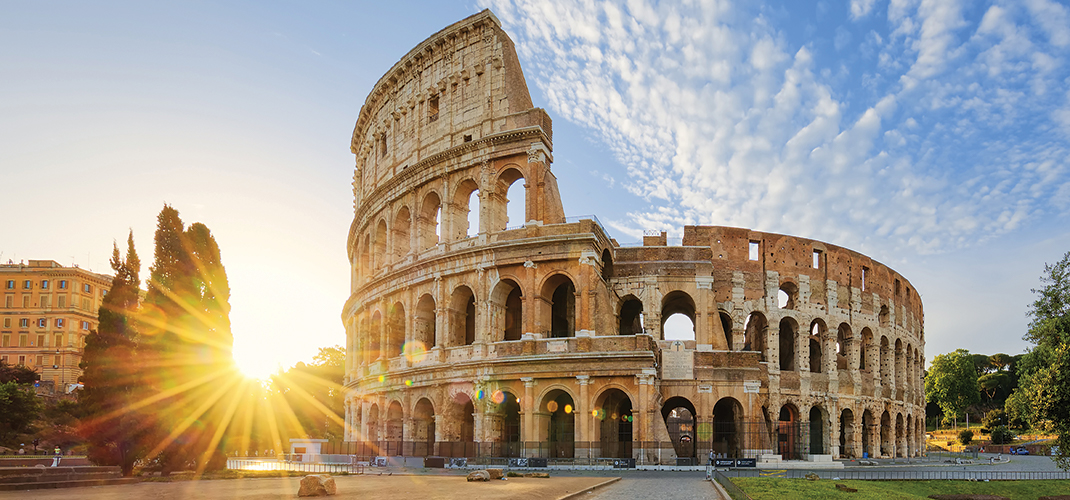Rome

Rome is an amazing city filled with icons of antiquity and the Christian faith, there is so much to see and do we cannot cover it all. Rome is so large it can be overwhelming however, the big sites of the Colosseum, Trevi Fountain, Spanish Steps, Roman Forum, Palatine Hill, Piazza Navona, the Catacombs and the Vatican City are a must on any trip.
The Basilica di Santa Maria Maggiore is one of the largest Churches in Rome, situated in the Piazza of the same name. The front of the building features a central array of stone columns topped with statues and inscriptions. However, the interior of the Church is breathtaking and features a huge amount of gold decoration, fresco’s and detailed paintings both on the walls and ceilings.
The Colosseum is one of the most renowned and iconic landmarks in the world. Also known as the Flavian Amphitheatre and was inaugurated in the year 80 AD with a series of splendid games and was estimated to hold at its peak 80,000 spectators. The Colosseum was used to hold circuses, theatrical performances, gladiator tournaments and other forms of entertainment and would regularly be attended by the Roman Emperors. Located beside the Colosseum stands the Arch of Constantine a triumphal arch erected by the Senate to honour the Emperor as ‘liberator of the city and bringer of peace’ after his victory in the battle of the Milvian Bridge in 312.
Strategically set 50 metres above the Tiber, the Palatine Hill shows evidence of Rome's earliest settlement with rock cuttings found in front of the Temple of Cybele showing human activity as long ago as the 9th Century B.C. The site was later chosen by Emperors and great aristocratic families for their Palaces. Highlights of Palatine Hill are the House of Livia (Augustus' wife), the semi-subterranean Cryptoporticus, Domus Flavia, Domus Augustana and most impressive of all, the Baths of Septimius Severus.
The Roman Forum is situated in the middle of the city however, you feel like you are stepping back two millennia into the heart of ancient Rome. What has survived is only a fraction of its original splendour, the standing and fallen columns, its triumphal arches and remains of its walls still impress, especially when you consider that for centuries, the history of the Forum was the history of the Roman Empire and of the Western world. Highlights include the Temple of Antoninus Pius, the Temple of Castor and Pollux, the Temple of Saturn, the Arch of Septimus Severus, the Curia, the Temple of Vesta and the Arch of Titus.
The Quirinale Palace and complex stands as one of the official residencies of the current President of Italy and is located on the Quirinal Hill in the centre of Rome. The complex spans 110,500 square metres and is one of the largest Palaces in the world. Inside the main part of the Palace are a series of richly decorated rooms, courtyards, staircases and Chapels. The Quirinale Gardens are also considered to be quite spectacular.
The 17th Century Fontana di Trevi (Trevi Fountain) is one of the most popular tourist attractions in Rome. Created for Pope Clement XII between 1732-1751, Rome's largest fountain is supplied by an aqueduct originally constructed by Agrippa, the great art patron of the 1st Century B.C. to bring water to his baths. Depicting the sea god Oceanus (Neptune) with horses, tritons and shells, the water swirls around the figures and the artificial rocks and collects in a large basin, always filled with coins. Tradition says if you throw a coin into the fountain you are supposed to return to Rome.
The Borghese Gardens is one of Rome’s largest parks containing a number of attractions that include two museums, the most prominent of which is the Villa Borghese. Built as a party villa and to house the Borghese art collection, the gallery contains paintings, sculptures, mosaics and reliefs most from the 15th-18th Century and include works by Raphael, Titian, Caravaggio and Rubens.
Constructed by Emperor Hadrian in 118 AD, the monumental Pantheon is one of the best preserved ancient Roman buildings and one of Rome’s most famous attractions. The interior features a magnificent dome that has a series of stone patterns and a central coffer that allows light to spill through.
Piazza Navona is one of Rome most characteristic squares, which still has the outline of the Roman stadium built here by Emperor Domitian. It was still used for festivals and horse races during the Middle Ages and was rebuilt in the Baroque style by Borromini, who also designed the magnificent series of Palaces and the Church of Sant'Agnese. Although Borromini designed the square and its surrounding façades, it was Bernini who created its centrepiece, the beautiful Baroque fountain, Fontana dei Fiumi. The two other fountains in the square are the 16th Century Fontana del Moro in front of the Palazzo Pamphili and the 19th Century Fontana del Nettuno with its figure of Neptune.
The Centro Storico is the historic centre of Rome, filled with Churches, Palaces and lively squares. The Spanish Steps is a flight of irregular stairs and landings that lead up to the French Church of Trinità dei Monti. The stairs take their name from Piazza di Spagna, the plaza at their base and one of Rome's many typical squares. The boat shaped fountain at the foot of the Spanish Steps is known as the Barcaccia created, by Pietro Bernini. Via Condotti that leads southwest from Piazza di Spagna is Rome's most fashionable shopping street.
The Piazza del Popolo is one of the finest squares in Rome. Symmetrically situated at the apex of a triangle of streets including the Via Corso it was designed in the early 19th Century as the northern entrance to the city centre. The Piazza del Popola (translating to Square of the People) is surrounded by historical structures such as the Chiesa di Santa Maria dei Miracoli, the Porta del Popolo gateway and the Basilica Parrocchiale. Standing in the centre of the Piazza is the huge Popolo Obelisk called Flamino, which like the one present in St. Peter’s Square was moved from Egypt. To the east of the square lies the Pincio Hill, offering fantastic views over the Piazza and Rome.
The Castle Saint Angelo also known as the Mausoleum of Hadrian, is a circular Fort and Castle complex. Created in 129 AD, this ancient Castle was originally intended to serve as a Mausoleum for the Emperor. With time, the Castle became part of the Vatican State and was connected to St. Peter’s Basilica via a huge corridor named the Passetto di Borgo. Today, the Castle is a Museum with exhibits about the history of the structure. Climb to the top for superb views over St. Peter’s Square and the city of Rome.
Vatican City is the smallest Independent State in the world, with an area of less than half a square kilometre, most of it enclosed by the Vatican walls. Inside you will find the Vatican Palace and Gardens, St. Peter's Basilica and St. Peter's Square, an area ruled by the Pope, supreme head of the Roman Catholic Church. Inside the Vatican Palace are the Raphael Rooms; the Borgia Apartments; the Vatican Library, plus a number of other museums that include the Picture Gallery, Museum of Secular Art and Etruscan Museum amongst others with collections that include everything from Papal coaches to 20th Century art reflecting religious themes. The Sistine Chapel is located in the Apostolic Palace and is famous for its extensive and details adornments include the Last Judgement fresco by Michelangelo and the ceiling artwork. These are two priceless pieces of artwork considered some of the most influential and important in religious history.
